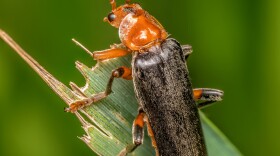About an inch-and-a-half long and shiny black in color, it’s easy to see how Bess Beetles received their other common name of “patent leather beetle”, because they look like a polished leather dress shoe.
With about 400,000 described species of beetles on the planet, Bess Beetles stand out from this buggy crowd in a number of ways.
While social behavior is the norm with insects like ants, honeybees, bumblebees, and yellowjackets, beetles are typically solitary animals. Bess Beetles are an exception.
A male and female pair create what’s called a “subsocial” relationship where the parents, growing larvae, and newly emerged adults all live together, but in a less complex structure than something like that of an ant or honeybee colony.
With Bess Beetles, both Mom and Dad take care of their developing larvae. But it goes beyond that. Even the parent’s older offspring, that recently became adults themselves, will spend time taking care of their younger brothers and sisters.
Just like within any human family, the ability to communicate would certainly come in handy. As it turns out, Bess Beetles are unique in this ability too.
While other beetles are known to make various squeaks and hisses, Bess Beetle adults and larvae can make 14 distinctly different sounds to convey danger to the rest of the family, attract a mate, and enable family communications.
One trait these interesting insects share with many other beetles is the fact that beetles are strong. While an adult Bess Beetle may only weigh 1 to 2 grams, they are capable of pulling up to 50 times their own weight.
That would be the equivalent of me pulling the weight of an African Bush Elephant.





